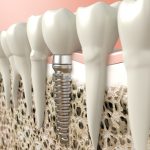An upper jaw that is misaligned, i. e. set back or smaller than the lower jaw, can have various cosmetic drawbacks for the person concerned. Beyond physical appearance, this misalignment can lead to several functional problems and abnormal wear and tear of the teeth. When there is an offset between the upper and lower teeth, it is usually referred to as malocclusion, which is often the result of jaw misalignment. When the upper jaw is set back from the lower jaw, it is primarily referred to as a narrow upper jaw.
Discover the causes and consequences of a misaligned upper jaw and the solutions to fix it.
The main causes of a misaligned upper jaw
Several factors can contribute to a misaligned upper jaw. In the vast majority of cases, it can simply be due to heredity, when other family members are faced with the same problem. In most cases, the misalignment is due to an upper jaw that is too small or too narrow in relation to the lower jaw. Indeed, it is more rare to see a normal upper jaw with an oversized lower jaw. This particular situation is explained by excessive growth of the lower jaw. A lack of development of the upper jaw can be explained, in some cases, by bad habits during development but is more frequently hereditary.
Apart from determining the cause, it is essential to consult a professional to see if treatment is necessary. In the long term, neglecting to address your jaw will risk damaging your teeth and causing chewing and even phonetic difficulties.
What are the consequences of upper jaw narrowing?
Beyond the cosmetic aspect, which can give the appearance of a hollow cheek and a lack of definition of the upper lip, jaw misalignment can have various restrictive consequences for the people affected. Tooth wear disorders due to misalignment of upper and lower teeth, chewing difficulties and speech disorders are fairly common findings in patients with upper jaw narrowing.
It is therefore important to manage this problem from an early age in order to avoid more serious consequences and intervene at the right time.
What solutions should you choose to correct malocclusion from a misaligned upper jaw?
There are two methods to correct this problem depending on the magnitude of the misalignment:
Orthodontic treatment
If the offset between the upper and lower teeth is minimal, orthodontic treatment can be enough to correct the problem. This can be provided if the bone bases are not too far apart or that there is no cosmetic impact from the malocclusion.
Orthodontic treatment is performed by an orthodontist. The orthodontist has several treatment approaches with various devices for tooth alignment, ranging from conventional braces to transparent aligners.
If orthodontic treatment is found to be insufficient to correct the malocclusion, then orthodontic treatment in combination with orthognathic surgery will be recommended.
Orthognathic surgery
Indeed, if the misalignment between the upper and lower teeth is due to a misalignment of the underlying bone bases, then a correction must be made to the underlying bone bases in order to properly correct the malocclusion and restore facial balance. When the upper jaw is at fault and too small compared to the lower jaw, it is recommended to wait until the end of growth before performing the surgery. With orthognathic surgery, the jaws will be repositioned appropriately with respect to each other, depending on the facial proportions and the position of each individual’s teeth. This procedure is performed under general anaesthesia in a hospital by an oral and maxillofacial surgeon.
Orthodontic treatment should be started prior to surgery in most cases, in order to prepare for dental alignment and achieve the best results.
Clinique MFML: a solution to jaw problems adapted to you
If you have a problem with your jaw, Clinique MFML specializes in orthognathic surgery. Contact our team for an appointment with one of our surgeons. We can offer you the best solution for your needs.




